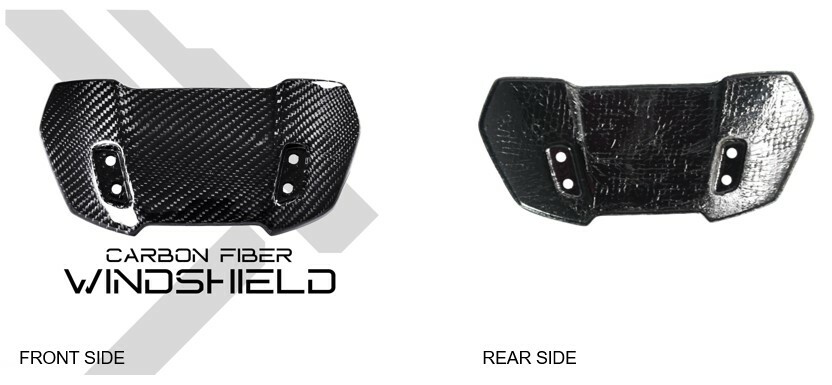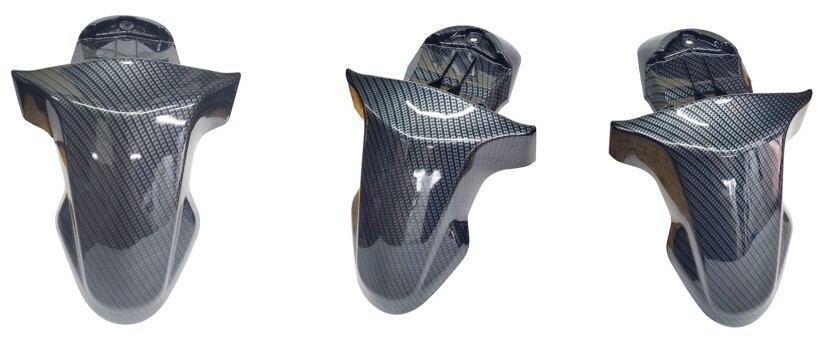Carbon fiber is often associated with luxury and high-performance motorcycles, scooters, and vehicles due to its lightweight, strong, and visually striking characteristics. Luxury automotive manufacturers and aftermarket companies frequently use carbon fiber to create luxurious and high-end automotive parts that enhance both aesthetics and performance, including MOS Motor Taiwan which specializes in continuously developing luxurious carbon fiber parts and accessories using 100% 3K Japanese carbon fiber.
Those trends and the popularity of carbon fiber generate many imitation products on the market, often referred to as "carbon fiber style," "carbon fiber look," or "carbon fiber pattern," is a type of material designed to mimic the appearance of real carbon fiber without possessing the same mechanical properties or characteristics. Here's a comparison between the two:

Picture 1. MOS Carbon Fiber Goggle Windshield for Yamaha Zuma 125 2022-2023 (Made of Real 100% Carbon Fiber)
Real Carbon Fiber:
- Material: Real carbon fiber is a composite material made from thin carbon fibers bonded together with resin. It's known for its high strength-to-weight ratio, stiffness, and durability.
- Appearance: Real carbon fiber has a distinctive woven pattern called a "twill weave" or "plain weave." It is often glossy and has a unique aesthetic that many find appealing.
- Weight: Real carbon fiber is lightweight, making it ideal for applications where weight reduction is important, such as in the aerospace, automotive, and sports equipment industries.
- Properties: It offers excellent mechanical properties, including high tensile strength, low thermal expansion, and resistance to corrosion and chemicals.
- Cost: Real carbon fiber is relatively expensive to produce due to the materials and manufacturing processes involved.
- Use Cases: It's commonly used in high-performance applications like race cars and motorcycles, high-end sports equipment (bicycles, tennis rackets), and aerospace components.


Picture 2. Water Printing Carbon Fiber Front Fender (Made of Plastic)
Imitation Carbon Fiber (Carbon Fiber Look or Style):
- Material: Imitation carbon fiber is usually made from materials like plastic, or fiberglass that are printed or textured to mimic the appearance of real carbon fiber.
- Appearance: It replicates the look of carbon fiber, often with a similar woven pattern, but lacks the depth and texture of real carbon fiber.
- Weight: The weight of fake carbon fiber can vary depending on the materials used, but it's generally heavier than real carbon fiber.
- Properties: Fake carbon fiber lacks the mechanical properties of real carbon fiber, and it doesn't offer the same strength, stiffness, or durability.
- Cost: Fake carbon fiber is more affordable than real carbon fiber due to the lower production costs.
- Use Cases: It's typically used for aesthetic purposes, such as interior trim pieces in cars, phone cases, laptop skins, and other consumer products.
Distinguishing between real carbon fiber and imitation can sometimes be challenging, as imitation products have become more sophisticated over time. However, there are a few methods you can use to help determine whether a carbon fiber item is genuine or not
Visual Inspection:
- Real carbon fiber typically has a distinct weave pattern that is uniform and consistent. Imitation carbon fiber may have irregular or less defined weave patterns.
- Look for any imperfections or inconsistencies in the weave, such as gaps, overlaps, or distortions.
- Real carbon fiber often has a glossy finish, while imitation products might have a lower-quality gloss or shine.
Texture and Feel:
- Authentic carbon fiber usually has a smooth yet slightly textured feel to the touch. Imitation materials might feel plasticky or have a less refined texture.
Weight:
- Carbon fiber is known for being lightweight and strong. If an item appears to be carbon fiber but feels excessively heavy, it could be an imitation.
Sound Test:
- Gently tap the item with your fingernail or a small object. Real carbon fiber tends to produce a distinct, sharp, and metallic sound, while imitation materials may sound more dull or plastic-like.
Edges and Details:
- Genuine carbon fiber products often have well-defined edges and clean, precise cuts. Imitation items may have rough or poorly finished edges.
Price and Source:
- Be wary of products that are being sold at significantly lower prices than what you would expect for genuine carbon fiber. If a deal seems too good to be true, it might be worth investigating further.
Manufacturer's Information:
- Research the manufacturer and brand of the product. Reputable and established brands are more likely to produce authentic carbon fiber products.
Professional Inspection:
- If you're still uncertain, consider seeking the opinion of an expert or someone knowledgeable about carbon fiber materials.
At MOS Motor Taiwan, We provide products made of 100% real 3K carbon fiber with a glossy finish and produced using Vacuum VARTM Technology, which is a high-quality production method.


Picture 3. MOS Carbon Fiber Production Process
MOS Carbon Fiber Characteristics:
- Made of 100% 3K Japanese Carbon Fiber
- Glossy Surface Finish and UV protection
- Manufacturing Process: Vacuum VARTM
- Pattern: Twill Weave
- Made in Taiwan (High-Quality Control Standard)
- Fits your Bike/ Car without adjustment/ cutting needed
MOS Carbon Fiber Parts and Accessories would be a great option for those who are looking to upgrade their motorcycles/ scooters/ vehicles with high-quality and luxurious carbon fiber products.
To explore our products please visit our website at www.mosmotortaiwan.com or send us an e-mail at sales2@motofun.com.tw
"MOS – Make your Own unique Style" (August 17, 2023)


